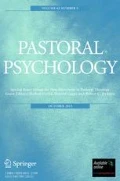Abstract
The adventure stories that boys enjoy reading often depict male characters in their exposed becoming and dreaming. Boys are drawn to these adventuring characters in part because such characters portray a masculinity that feels more human than the otherwise stoic masculine norms of Western culture. Taking a cue from adventure literature, this paper addresses adventure and the dreaming spirit as avenues of self-understanding in boyhood. In adventure, this sense of exposure is not experienced in relation to shame but in relation to possibility. Adventure and the dreaming spirit are both motifs that lend themselves to Christian living. Viewing selfhood as adventure can provide boys with a self-concept that feels human. Boys do not always have friendships of mutual trust in their lives where they feel secure addressing their becoming and dreaming. Persons in pastoral roles can offer this kind of accompanying and affirming friendship to boys in their becoming.
Similar content being viewed by others
References
Anderson, R. S. (1991). On being human: Essays in theological anthropology. Wipf and Stock.
Badhwar, N. K. (1987). Friends as ends in themselves. Philosophy and Phenomenological Research, 48, 1–23.
Bean, T. W., & Harper, H. (2007). Reading men differently: Alternative portrayals of masculinity in contemporary young adult fiction. Reading Psychology, 28(1), 11–30. https://doi.org/10.1080/02702710601115406.
Beardsley, M. C. (1981). Aesthetics: Problems in the philosophy of criticism (2nd ed.). Hackett.
Bennett, S. J. (2013). “A wisdom that is woe”: Allusions to Ecclesiastes in Moby-Dick. Literature and Theology, 27, 48–64. https://doi.org/10.1093/litthe/frs019.
Bretherton, R. (2006). Can existential psychotherapy be good news? Reflections on existential psychotherapy from a Christian perspective. Mental Health, Religion & Culture, 9(3), 265–275. https://doi.org/10.1080/13694670600615490.
Brock, B., & Hauerwas, S. (2017). Beginnings: Interrogating Hauerwas (K. Hargaden, Ed.). Bloomsbury.
Clutterbuck, D. (2004). Everyone needs a mentor: Fostering talent in your organization (4th ed.). C.I.P.D.
Cooper, M. (2017). Existential therapies (2nd ed.). Sage.
Cupchik, G. C., Oatley, K., & Vorderer, P. (1998). Emotional effects of reading excerpts from short stories by James Joyce. Poetics, 25(6), 363–377.
De Vries, R. J. (2013). Becoming two in love: Kierkegaard, Irigaray, and the ethics of sexual difference. Pickwick.
Dykstra, R. C. (2007). The birth of the born loser. In R. C. Dykstra, A. H. Cole Jr., & D. Capps (Eds.), Losers, loners, and rebels: The spiritual struggles of boys (pp. 27–44). Westminster John Knox.
Dykstra, R. C. (2012). Unrepressing the kingdom: Pastoral theology as aesthetic imagination. Pastoral Psychology, 61(4), 391–409. https://doi.org/10.1007/s11089-011-0418-8.
Garland, A. (1996). The beach. Viking.
Hall, C., & Coles, M. (1997). Gendered readings: Helping boys develop as critical readers. Gender and Education, 9, 61–68.
Hamman, J. (2017). The reproduction of the hypermasculine male: Select subaltern views. Pastoral Psychology, 66, 779–818. https://doi.org/10.1007/s11089-017-0775-z.
Hoyt, E. P. (1961). Lost statesmen. Reilly & Lee.
Kierkegaard, S. (1941). The sickness unto death: A Christian psychological exposition for edification and awakening. In W. lowrie (Ed., Trans.), Fear and trembling and The sickness unto death (pp. 235–478.), Princeton University Press, 1941. (Original work published 1849).
Kierkegaard, S. (2014). The concept of anxiety: A simple psychologically oriented deliberation in view of the dogmatic problem of hereditary sin (A. Hannay, Trans.). Liveright. (Original work published 1844).
Klempe, S. H. (2013). Kierkegaard and psychology as the science of the multifarious life. Integrative Psychological & Behavioral Science, 47(1), 367–375. https://doi.org/10.1007/s12124-013-9235-1.
Krakauer, J. (1996). Into the wild. Anchor Books.
Langer, S. K. (1957). Philosophy in a new key: A study in the symbolism of reason, rite, and art (3rd ed.). Harvard University Press.
Langhout, R. D., Rhodes, J. E., & Osborne, L. N. (2004). An exploratory study of youth mentoring in an urban context: Adolescents’ perception of relationship styles. Journal of Youth and Adolescence, 33(4), 293–306.
Lewis, M. (1995). Shame: The exposed self. The Free Press.
McAdams, D. P. (1993). Personal myths and the making of the self. Guilford Press.
McKnight, S. (2019). Pastor Paul: Nurturing a culture of Christoformity in the church. Brazos.
Oatley, K. (1999). Meeting of the minds: Dialogue, sympathy, and identification, in reading fiction. Poetics, 26(5–6), 439–454.
Page, J., Jones, J. P., & Bonham, J. (1968). Good times bad times. Led Zeppelin [Recorded by Led Zeppelin]. [Album]. Olympic.
Peterson, E. H. (1980). Five smooth stones for pastoral work. Eerdmans.
Plantinga-Pauw, A. (2015). Proverbs and Ecclesiastes. Westminster John Knox.
Pollack, W. S., & Shuster, T. (2000). Real boys’ voices. Random House.
Riordan, R. (2005). Percy Jackson and the lightning thief. Puffin.
Robinson, G. (2009). Adventure and the way of Jesus: An experiential approach to spiritual formation. Wood ‘N’ Barnes.
Siberine, K. H., & Kimball, L. (2019). Confirming mentoring: Mutual experiences of incarnation. Theology Today, 76, 38–49. https://doi.org/10.1177/0040573619826950.
Sousa, D. (2017). Existential psychotherapy: A genetic-phenomenological approach. Palgrave Macmillan.
Sylvester, K. (2019). What do boys read? And why do they stop? Canadian Children’s Book News, 42, 17–19.
Tolkien, J. R. R. (2011). The Hobbit. HarperCollins. (Original work published 1937).
Walters, E. (2015). The rule of three. Square Fish.
Way, N. (2004). Intimacy, desire and distrust in the friendship of adolescent boys. In N. Way & J. Chu (Eds.), Adolescent boys: Exploring diverse cultures of boyhood (pp. 167–196). N.Y.U. Press.
Acknowledgements
A special thanks to Sam, Mitchel, Peter, Curtis, and Nate for your book club recommendations used in this paper. Your voices have shaped my thinking.
Author information
Authors and Affiliations
Corresponding author
Ethics declarations
The author has no relevant financial or non-financial interests to disclose.
Additional information
Publisher’s Note
Springer Nature remains neutral with regard to jurisdictional claims in published maps and institutional affiliations.
Rights and permissions
About this article
Cite this article
Clements, C.D. Nurturing a Dreaming Spirit: Pastoral Presence during the Boyhood Years. Pastoral Psychol 71, 127–139 (2022). https://doi.org/10.1007/s11089-021-00960-7
Accepted:
Published:
Issue Date:
DOI: https://doi.org/10.1007/s11089-021-00960-7




